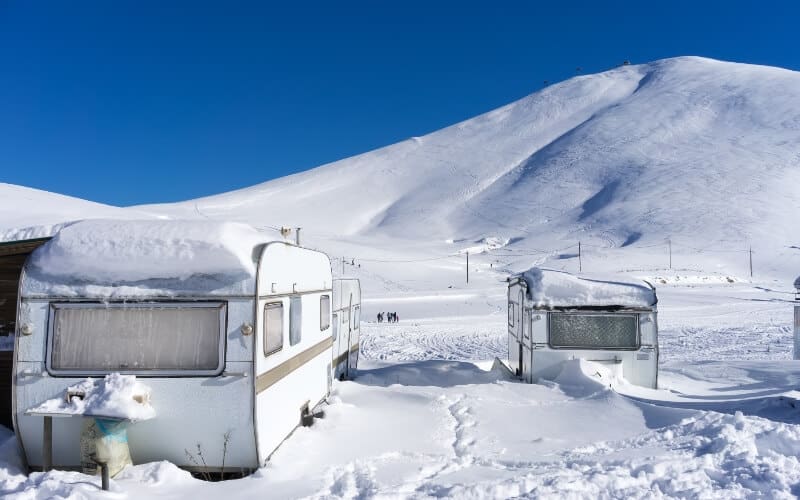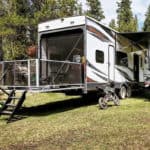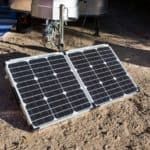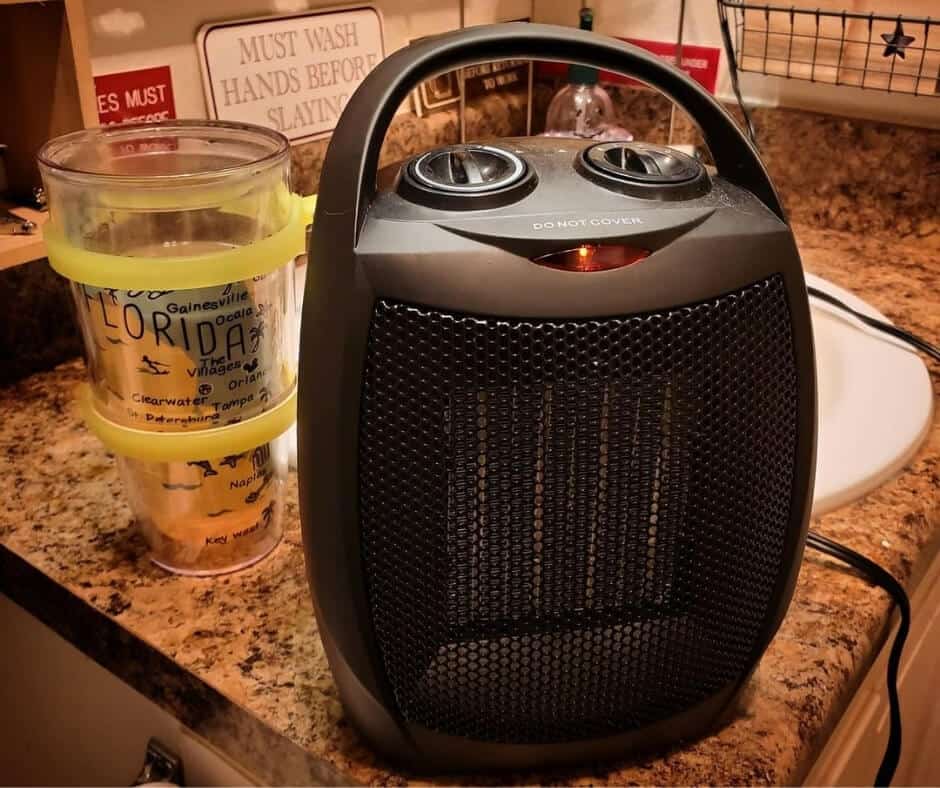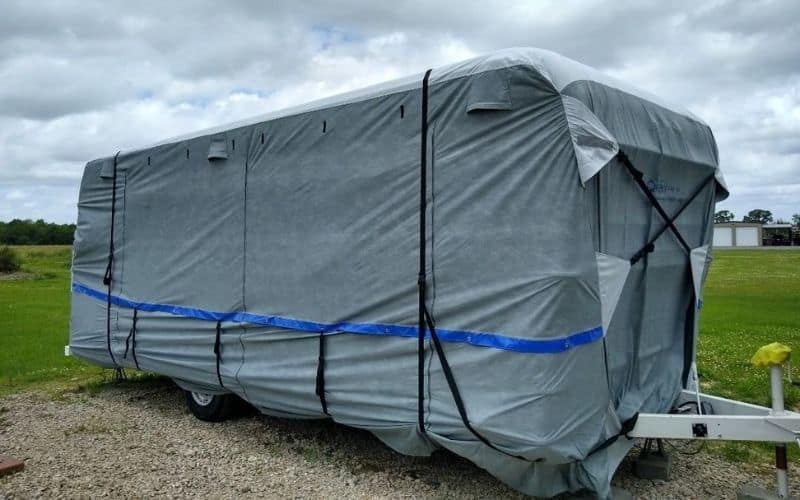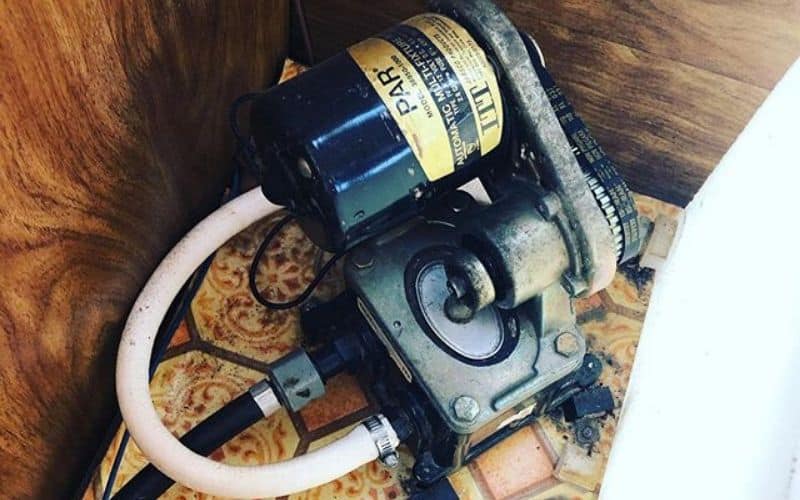Frozen RV water pipes can be more than just an inconvenience to your camping trip. Severely frozen pipes can cause serious damage to your RV’s water system and cause other unforeseen complications.
If you’re worried about how to keep your RV’s water pipes from freezing when the weather turns cold, there are a few things you can do. This includes steps like insulating your pipes in advance, trying to warm the pipes before the temperature dips too low, or draining the system when you know it’s going to get below freezing at night.
Let’s take a look at how to go about these simple, yet effective measures for keeping your RV’s water pipes from freezing when you go camping.
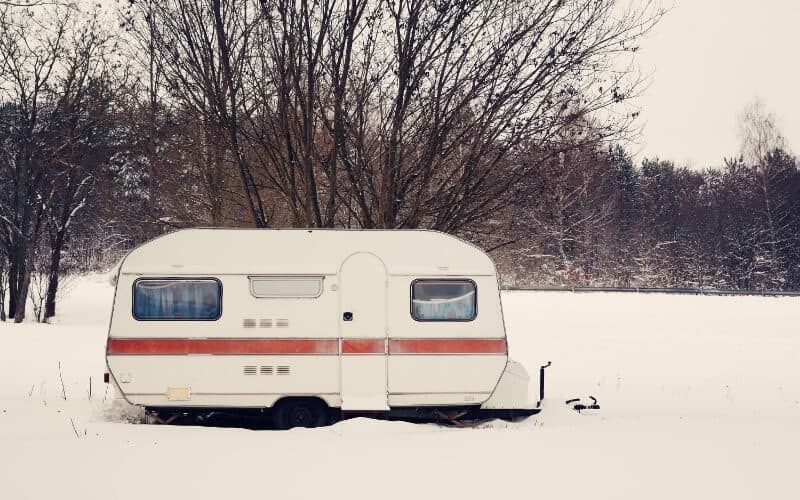
Tips To Help Prevent Frozen RV Water Pipes
There are a few different methods to consider when it comes to preventing RV water pipes from freezing.
The one that is best for your RV will depend on just how cold it’s going to get and how long it’s going to stay cold, as well as the characteristics of your RV.
Insulating Your RV’s Water Pipes
In an RV the thing that is most likely to freeze first is the freshwater line going from the storage tank to the sinks and other plumbing fixtures inside the RV.
This is even more likely to be a problem if your RV’s waterlines move exposed through the underbelly.
If you are planning to take a winter camping trip with your RV, or you’ll simply be staying at altitude during a possible cold snap, you should think about insulating your RV’s pipes.
If you are a frequent winter camper you might want to go so far as to seek out a professional contractor who can apply closed-cell spray foam insulation.
This can coat your entire underbelly with durable, high-R value insulation. You might also want to invest in winter skirting, which you temporarily install around the exterior of the RV once it’s parked up.
This helps trap any ambient heat under the RV as well as keep the wind from driving the temperatures down.
The bonus of insulating the RV underbelly is that it helps keep your floors warm.
It even helps with thermal efficiency, so your RV furnace uses less propane to maintain a comfortable temperature inside.
If you are going to be camping at elevation or there is a fall cold snap threatening to freeze out your hunting trip, you can probably get by with some standard pipe insulation from a hardware store.
Installing it yourself can be a little bit of a challenge in tight spaces, but it should keep your water lines from freezing if the temperatures dip below 32 degrees for a few hours at night.
Zip ties and duct tape will help lock them in place once you’re parked up.
I just wouldn’t recommend driving down the high way at speed without some more permanent way to affix them.
Running The Water Through The Night
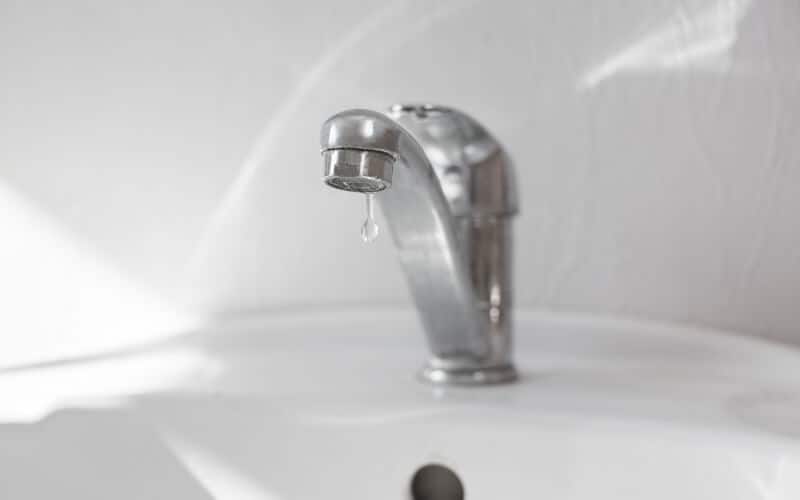
It’s a principle truth of physics that running water is much harder to freeze.
In fact in northern states during harsh winters a lot or residential homes will leave a sink running in their basement to keep the frozen ground from freezing the municipally supplied water pipes.
Of course, with an RV the problem is that you’re working with a limited supply in your freshwater tank, and the stream of water that you need to keep a line from freezing between zero to 32-degrees Fahrenheit is about the thickness of a pencil.
Admittedly, this is a trick only to be used in desperate times, or perhaps if a cold snap hits on the last night of a hunting trip.
Though if you are staying at a four-season RV park, where you have easy access to a resupply of freshwater and an RV dump site for your gray water, this might be a more practical solution.
Keeping The Internal Temperature Of The RV Warm
If your freshwater lines run through the body of the RV or through the floor, instead of the exposed underbelly, keeping the interior of the RV warm will help stave off the freezing effect inside the water lines.
Though this might make for some hot and sweaty sleeping conditions. Just how hot you need to keep will depend on where your water lines are and how well your floors are insulated.
Install A Tank Heating Pad
Tank heating pads are essentially a series of small electrical resistors that generate a mild amount of heat.
They can be applied to water tanks and freshwater lines to help keep them from freezing.
Most have a built-in thermostat that lets you turn it up at night when the temperature will be at their coldest, then turn it down in the morning when things start to warm up.
This is a good option if you are going to be staying at a location where prolonged cold weather is in the forecast.
This is a good option for times when the forecasted nightly low is going to dip below 32-degrees, but not go subzero.
Combining this method with some insulative skirting also helps trap ambient heat and reduces the risk of wind chill contributing to the problem.
Run A Propane Heater Under The RV

This method is only truly effective if you also have insulated skirting to trap the warm air under the RV.
Without something to block the wind and hold in the heat, a Sunflower or other type of portable propane heater simply won’t be able to keep up.
If you are going to use this method, you also need to be smart about fire safety and ventilation.
Even the most efficient of propane heaters still produces a little bit of fumes and carbon monoxide.
Just like in a portable fish shanty, you need to give the heater some type of ventilation to keep these gasses from building up and infiltrating the interior of your RV.
Also, keep in mind that the heat will be the highest near the propane heater. So, look very closely for anything flammable or combustible above and nearby.
Then make a point to periodically check on the heater and the surroundings throughout the night.
Empty Your Tanks And Water Lines
If you are staying at an RV park, or the forecasted temperatures have truly got you worried, you might need to go all out and empty all your tanks and lines.
This will prevent the water inside them from freezing, which could crank fittings, split hoses, and even cause expensive damage to the tanks themselves.
If you are still connected to an RV park’s resources, you want to double-check to make sure that all the lines in and out are at a downward slope.
Even the slightest loop or bow can trap water which makes it much more prone to freezing or causing a clog of slushy water.
Frequently Asked Questions
Will My RV Pipes Freeze?
The order in which things freeze can vary depending on how your RV is setup. As the water starts to cool from 39 to 32 degrees Fahrenheit, it can go through what’s called a “Transition Phase.”
As it approaches 32 degrees the expansion of the water and the lack of thermal energy can start to turn it into slush.
You might have noticed this with a can of soda left too long in the freezer, when you first open it the soda is liquid for a few moments before it turns into undrinkable slush.
Most RV freshwater lines are strong enough to handle water in its transition phase. If you have strong water pressure you might even be able to get slushy water moving again.
Once water moves from the transition phase toward truly freezing the first things that are vulnerable are the seams where metal fittings meet flexible water lines.
The pressure of water expanding into ice simply breaks the connection. A small amount of water usually seeps out before it freezes.
Once this happens you will need to repair the connection between the line and the fitting, which usually requires running a new water line.
What Are The Most Vulnerable Things To Freeze In An RV Water System?
The water pump and its protective housing are usually the next most vulnerable thing to freeze.
The impeller inside the pump and other delicate components can sometimes fracture under the pressure of expanding ice.
The freshwater storage tank under your RV is the next most vulnerable thing. Usually, you see a failure in waterline or fitting before you see a freshwater storage tank freeze.
This is because water is such a great heat sink and the more of it there is in one place the more heat energy needs to be drawn out of it to cause it to go into transition phase or freeze completely.
The gooseneck drains of your sinks and toilet are technically vulnerable if you have been away and you haven’t been running the heat.
Most people who are going to leave their RV unattended during the fall or winter will pour RV antifreeze into all the drains to keep this from happening.
The gray and black water storage tanks are the next vulnerable thing to freeze in an RV.
The soap and organic material in solution essentially act like road salt does and lowers the actual freezing point.
Add in any water from the hot water heater or water that’s been warmed by the interior of the RV and it makes it difficult to truly freeze black and gray water.
Usually, you see a far more serious failure in the freshwater lines and fittings before you have a problem with the wastewater storage tanks.
At What Temperature Will My RV Water Lines Freeze?
There’s no hard and fast rule as to the precise outside temperature that the RV water lines themselves freeze.
Things like wind, the ambient warmth of the RV and your own measures to prevent freezing will all factor into just what temperature and how long it takes for the lines to freeze.
A wise rule of thumb is to take precautions anytime the temperatures are forecasted to be less than 32-degrees Fahrenheit.
What To Do If Your RV Plumbing Freezes
Let’s say you caught your frozen RV waterlines before any fittings split or waterlines cracked.
This means you’ve still got time to get things moving again before you’re staring at an expensive repair bill. Though you still do need to act fast.
Step 1: Try to locate where the frozen area is.
Check to make sure all your fixtures are indeed out of water. If one is running and others are not, then the frozen section of the line is between the fixtures.
If nothing is moving then it’s likely the line is frozen through the underbelly.
Step 2: Place a heater near the water pump area.
If the lines are freezing in the underbelly the water pump is the most expensive component that is at risk.
A damaged water line or a fitting is much cheaper to repair or replace than the pump. Also, you might need the water pump later to keep things moving through the water lines.
Step 3: Wrap heat tape around pipes and fittings.
This is another type of small resistor that will transfer heat energy into the metal to help thaw out the lines.
Generally, it doesn’t get hot enough to melt plastic, but you still might want to keep an eye on it just to make sure.
Step 4: Use a plumber’s torch to heat metal components
A plumbers torch or propane torch can be used to heat metal components quickly.
This will reduce the chances of them cracking or splitting on you. Just keep an eye out for flammable or combustible materials near the metal fittings you are trying to warm.
Step 5: Keep the plumbing fixture in the RV open.
As the line starts to thaw the water pressure should return. This is assuming the water pump itself wasn’t damaged.
Once the water starts to pass through the system again, leave it running wide open for a good half hour to make sure you’ve got all the ice and any transition phase slush out of the lines.
Be prepared with buckets and towels just in case one of the fittings or lines has a surprise leak in it that you didn’t notice when it was frozen.
Conclusion
When it comes to freezing RV pipes an ounce of prevention is certainly better than a pound of expensive repairsIf you are taking a cold weather RV trip, or you are planning to stay at altitude where even summer temperatures can sometimes dip below freezing at night, you might want to consider one of the above methods for preventing frozen RV water pipes.

